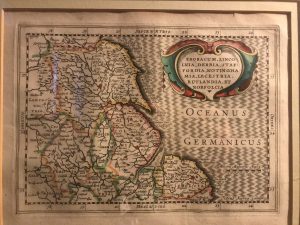
The Pit Stop History Health Walks take place every Monday, 11-12:30. However, today, we had an indoor session at the Men’s Centre where I talked about some of my collection of historic maps, artefacts and books. Among the things we looked at was this maritime map depicting the eastern coast of England, including Norfolk, and the North Sea (or, the ‘German Ocean’ as it would have been known back then). The cartographer, who made this map, is named in a Latinised form as, ‘Petrus Karius’ in the bottom right-hand corner of the map. Pieter van den Keere (1571-1646) was a Flemish engraver, publisher and globe maker. Pieter was, for a time, a refugee living in London, where, around 1599, he made this map. As I think you will agree it is a handsome and fascinating artefact – and with all those hills covering Norfolk you could easily get the impression that this is a hilly county (it’s all relative I guess). Anyway, interesting though this map is, it was far from the most interesting thing we looked at today.
I had invited the members to bring in objects with some meaning or connection to them. For me, the most poignant was a group of photographs that once belonged to a World War Two British soldier, a relative of Peter. Peter explained to us how this young man had been killed by a German sniper’s bullet to the chest, whilst serving in Italy in December 1944. He then revealed the photograph that had been in his breast pocket and there it was – a picture of his mother and father, held close to his heart, with a bullet hole through it. Having been involved in lots of object handling and reminiscence sessions over the years, I’ve seen a lot of amazing artefacts, but this is, I think, the most powerful and poignant I have ever witnessed.
Thanks to everyone for sharing your stories, insights and good company today!
Colin

Glad I read this. Very interesting and helpful. Paul.